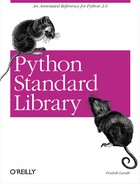The locale module, as shown in Example 8-1, provides an interface to C’s localization functions. It
also provides functions to convert between numbers and strings based
on the current locale. (Functions like int and
float, as well as the numeric conversion
functions in string, are not affected by the
current locale.)
Example 8-1. Using the locale Module for Data Formatting
File: locale-example-1.py
import locale
print "locale", "=>", locale.setlocale(locale.LC_ALL, "")
# integer formatting
value = 4711
print locale.format("%d", value, 1), "==",
print locale.atoi(locale.format("%d", value, 1))
# floating point
value = 47.11
print locale.format("%f", value, 1), "==",
print locale.atof(locale.format("%f", value, 1))
info = locale.localeconv()
print info["int_curr_symbol"]
locale => Swedish_Sweden.1252
4,711 == 4711
47,110000 == 47.11
SEKExample 8-2 shows how you can use the locale module to get the platform locale.
..................Content has been hidden....................
You can't read the all page of ebook, please click here login for view all page.
